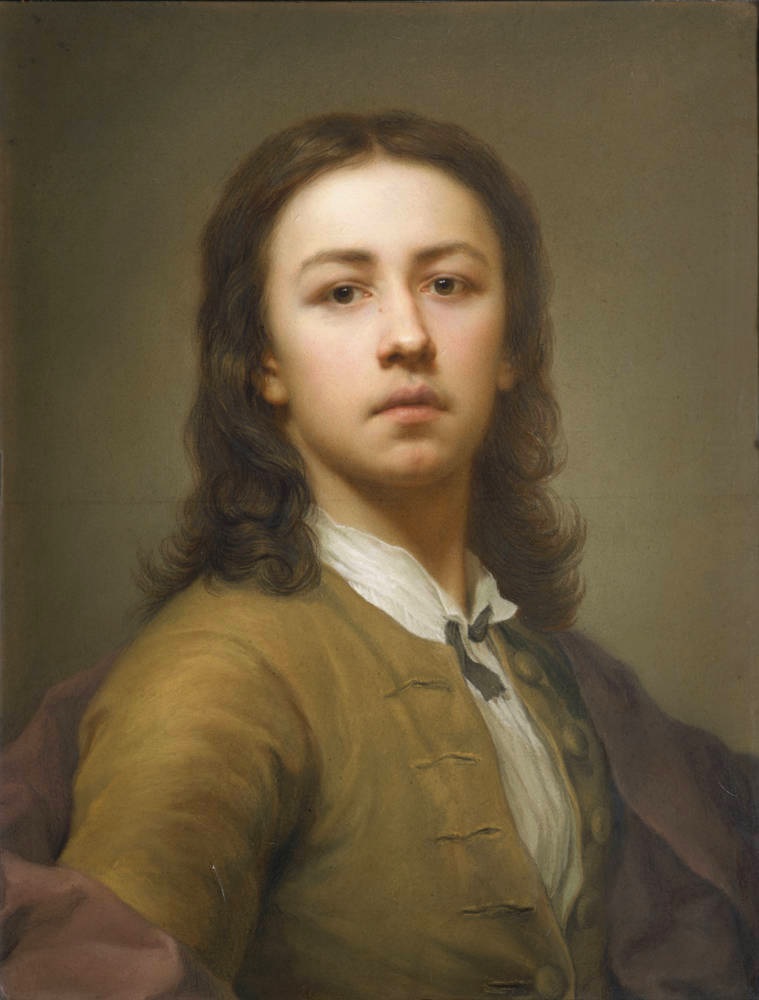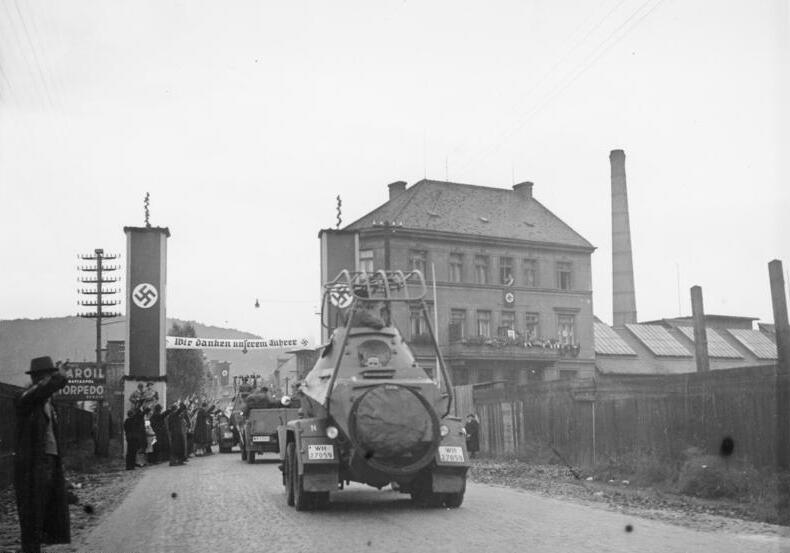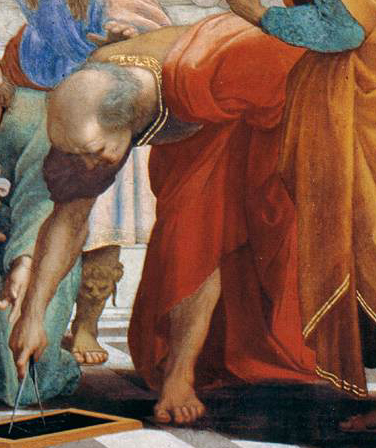|
Mengs
Anton Raphael Mengs (22 March 1728 – 29 June 1779) was a German painter, active in Dresden, Rome, and Madrid, who while painting in the Rococo period of the mid-18th century became one of the precursors to Neoclassical painting, which replaced Rococo as the dominant painting style in Europe. Early life Mengs was born in 1728 at Ústí nad Labem (German: Aussig) in the Kingdom of Bohemia, the son of Ismael Mengs, a Danish painter who eventually established himself at Dresden, where the court of Saxonian-Polish electors and kings was. His older sister, Therese Maron, was also a painter, as was his younger sister, Julia. His and Therese's births in Bohemia were mere coincidence. Their mother was not their father's wife; Ismael carried on a years-long affair with the family's housekeeper, Charlotte Bormann. In an effort to conceal the births of two illegitimate children, Ismael took Charlotte, under the pretext of "vacations", to the nearest bigger town abroad, Ústí nad Labe ... [...More Info...] [...Related Items...] OR: [Wikipedia] [Google] [Baidu] |
Anna Maria Mengs
Anna Maria Mengs, or Ana Carmona (1751–1792), was a German artist; known largely for portraits. Biography Born in Dresden, she was the daughter of the painter Raphael Mengs and his wife, Margarita Guazzi. She studied art with her father. In 1777, she married the Spanish engraver Manuel Salvador Carmona. They had seven children. Her works include portraits in pastel and miniature; that of her husband is in the Real Academia de Bellas Artes de San Fernando The Real Academia de Bellas Artes de San Fernando (RABASF; ), located on the Calle de Alcalá in the heart of Madrid, currently functions as a museum and gallery. A public law corporation, it is integrated together with other Spanish royal acade ..., to which Mengs was admitted as a member of merit on August 29, 1790. She died in Madrid in 1792 and was interred at St Sebastian's Church. In 1793, to mark the first anniversary of her death, the Academy of San Fernando presented an exhibition of Mengs' work.Smith, Ther ... [...More Info...] [...Related Items...] OR: [Wikipedia] [Google] [Baidu] |
Therese Maron
Therese Concordia Maron (née Mengs; 1725 – October 10, 1806), was a German (Saxon) painter, for most of her life active in Rome. She was the elder sister of more known painter Anton Raphael Mengs. Therese was born in northern Bohemian town of Ústí nad Labem (german: Aussig) into the Lutheran family of Danish painter Ismael Mengs, a ''hofmaler'' (court painter) at the court of Saxon-Polish electors and kings. Her birth in Bohemia was mere coincidence, because her father maintained an extramarital relationship with his housekeeper Charlotte Bormann and in an effort to conceal the birth of an illegitimate child, he decided to take the mistress under the pretext of "vacations" to the nearest bigger town abroad, namely to Ústí nad Labem (90 km upstream of the Elbe River), where she gave birth to daughter Therese Concordia. After a few weeks, Mengs took his daughter and her mother back to Dresden, the Saxon capital, where they lived. (Three years later he made the sam ... [...More Info...] [...Related Items...] OR: [Wikipedia] [Google] [Baidu] |
Therese Concordia Maron
Therese Concordia Maron (née Mengs; 1725 – October 10, 1806), was a German ( Saxon) painter, for most of her life active in Rome. She was the elder sister of more known painter Anton Raphael Mengs. Therese was born in northern Bohemian town of Ústí nad Labem (german: Aussig) into the Lutheran family of Danish painter Ismael Mengs, a ''hofmaler'' (court painter) at the court of Saxon-Polish electors and kings. Her birth in Bohemia was mere coincidence, because her father maintained an extramarital relationship with his housekeeper Charlotte Bormann and in an effort to conceal the birth of an illegitimate child, he decided to take the mistress under the pretext of "vacations" to the nearest bigger town abroad, namely to Ústí nad Labem (90 km upstream of the Elbe River), where she gave birth to daughter Therese Concordia. After a few weeks, Mengs took his daughter and her mother back to Dresden, the Saxon capital, where they lived. (Three years later he made the sam ... [...More Info...] [...Related Items...] OR: [Wikipedia] [Google] [Baidu] |
Julia Charlotte Mengs
Julia Charlotte Mengs (c. 1730 – after 1806) was a German painter. Julia Charlotte was born in Bohemia, into the Lutheran family of Danish painter Ismael Mengs, a ''hofmaler'' (court painter) at the court of Saxonian-Polish electors and kings. She was the younger sister of Therese Maron and Anton Raphael Mengs Anton Raphael Mengs (22 March 1728 – 29 June 1779) was a German painter, active in Dresden, Rome, and Madrid, who while painting in the Rococo period of the mid-18th century became one of the precursors to Neoclassical painting, which replace ..., and also embarked on a career as a court painter. However, in 1765 she entered the Belvedere Convent in the March of Ancona, taking the name of Sister Maria Speranda. She died there sometime after 1806. No work by Julia appears to have survived, although a pastel portrait of her traditionally described as being by her sister has sometimes been suggested to be a self-portrait instead. [...More Info...] [...Related Items...] OR: [Wikipedia] [Google] [Baidu] |
Ismael Mengs
Ismael Israel Mengs (1690 – 26 December 1765) was a Danish portrait painter. Born in Copenhagen into a family of Jewish descent, he learned the art of miniature- and enamel-painting in Lübeck, and then traveled through Germany, Italy, and Austria. He earned a scant livelihood until 1764, when he was appointed professor at the Academy of Art in Dresden, and court painter to August III Augustus III ( pl, August III Sas, lt, Augustas III; 17 October 1696 5 October 1763) was King of Poland and Grand Duke of Lithuania from 1733 until 1763, as well as Elector of Saxony in the Holy Roman Empire where he was known as Frederick Augu ..., from whom he received an annuity. References External links * 1690 births 1765 deaths 18th-century Danish painters 18th-century male artists 18th-century Jews Danish male painters Danish portrait painters Jewish Danish artists Portrait miniaturists {{Denmark-artist-stub ... [...More Info...] [...Related Items...] OR: [Wikipedia] [Google] [Baidu] |
Neoclassicism
Neoclassicism (also spelled Neo-classicism) was a Western cultural movement in the decorative and visual arts, literature, theatre, music, and architecture that drew inspiration from the art and culture of classical antiquity. Neoclassicism was born in Rome largely thanks to the writings of Johann Joachim Winckelmann, at the time of the rediscovery of Pompeii and Herculaneum, but its popularity spread all over Europe as a generation of European art students finished their Grand Tour and returned from Italy to their home countries with newly rediscovered Greco-Roman ideals. The main Neoclassical movement coincided with the 18th-century Age of Enlightenment, and continued into the early 19th century, laterally competing with Romanticism. In architecture, the style continued throughout the 19th, 20th and up to the 21st century. European Neoclassicism in the visual arts began c. 1760 in opposition to the then-dominant Rococo style. Rococo architecture emphasizes grace, ornam ... [...More Info...] [...Related Items...] OR: [Wikipedia] [Google] [Baidu] |
Villa Albani
The Villa Albani (later Villa Albani-Torlonia) is a villa in Rome, built on the Via Salaria for Cardinal Alessandro Albani. It was built between 1747 and 1767 by the architect Carlo Marchionni in a project heavily influenced by otherssuch as Giovanni Battista Nolli, Giovanni Battista Piranesi and Johann Joachim Winckelmannto house Albani's collection of antiquities, curated by Winckelmann. The villa has been conserved intact into the 21st century by the Torlonia Family, who bought it in 1866. In 1870, the treaty following the Capture of Rome from the Papal States was signed here. History Planned in 1743, the building of the villa began in 1747 according to Giuseppe Vasi and was celebrated as complete in 1763. Its purpose was to house Cardinal Albani's evolving and renewed collections of antiquities and ancient Roman sculpture, which soon filled the casino that faced the Villa down a series of formal parterres. The villa with its collection, fountains, statues, stairways an ... [...More Info...] [...Related Items...] OR: [Wikipedia] [Google] [Baidu] |
Victoria And Albert Museum
The Victoria and Albert Museum (often abbreviated as the V&A) in London is the world's largest museum of applied arts, decorative arts and design, housing a permanent collection of over 2.27 million objects. It was founded in 1852 and named after Queen Victoria and Prince Albert. The V&A is located in the Royal Borough of Kensington and Chelsea, in an area known as " Albertopolis" because of its association with Prince Albert, the Albert Memorial and the major cultural institutions with which he was associated. These include the Natural History Museum, the Science Museum, the Royal Albert Hall and Imperial College London. The museum is a non-departmental public body sponsored by the Department for Digital, Culture, Media and Sport. As with other national British museums, entrance is free. The V&A covers and 145 galleries. Its collection spans 5,000 years of art, from ancient times to the present day, from the cultures of Europe, North America, Asia and North Afri ... [...More Info...] [...Related Items...] OR: [Wikipedia] [Google] [Baidu] |
Ústí Nad Labem
Ústí nad Labem (, , ) is a city in the Czech Republic. It has about 92,000 inhabitants. It is the capital of its eponymous region and district. It is a major industrial centre and, besides being an active river port, is an important railway junction. Administrative division Ústí nad Labem is divided into four boroughs, which are further divided into 22 administrative parts: *Ústí nad Labem-město (parts Ústí nad Labem-centrum, Božtěšice, Bukov, Habrovice, Hostovice, Klíše, Předlice, Skorotice, Strážky, Vaňov and Všebořice); *Ústí nad Labem-Neštěmice (parts Krásné Březno, Mojžíř and Neštěmice); *Ústí nad Labem-Severní terasa (part Severní Terasa); *Ústí nad Labem-Střekov (parts Brná, Církvice, Kojetice, Olešnice, Sebuzín, Střekov and Svádov). Etymology The name of Ústí nad Labem is formed from the Old Czech ' ("river mouth") and ' (the Elbe River). It thus literally means "Mouth-upon-the-Elbe", in reference to its location at the ... [...More Info...] [...Related Items...] OR: [Wikipedia] [Google] [Baidu] |
The School Of Athens
''The School of Athens'' ( it, Scuola di Atene) is a fresco by the Italian Renaissance artist Raphael. The fresco was painted between 1509 and 1511 as a part of Raphael's commission to decorate the rooms now known as the , in the Apostolic Palace in the Vatican. It depicts a congregation of philosophers, mathematicians, and scientists from Ancient Greece, including Plato, Aristotle, Pythagoras, Archimedes, and Heraclitus. The Italian artists Leonardo da Vinci and Michelangelo are also featured in the painting, shown as Plato and Heraclitus respectively. The painting notably features accurate perspective projection, a defining characteristic of the Renaissance era. Raphael learned perspective from Leonardo, whose role as Plato is central in the painting. The themes of the painting, such as the rebirth of Ancient Greek philosophy and culture in Europe (along with Raphael's work) were inspired by Leonardo's individual pursuits in theatre, engineering, optics, geometry, ... [...More Info...] [...Related Items...] OR: [Wikipedia] [Google] [Baidu] |
Fresco
Fresco (plural ''frescos'' or ''frescoes'') is a technique of mural painting executed upon freshly laid ("wet") lime plaster. Water is used as the vehicle for the dry-powder pigment to merge with the plaster, and with the setting of the plaster, the painting becomes an integral part of the wall. The word ''fresco'' ( it, affresco) is derived from the Italian adjective ''fresco'' meaning "fresh", and may thus be contrasted with fresco-secco or secco mural painting techniques, which are applied to dried plaster, to supplement painting in fresco. The fresco technique has been employed since antiquity and is closely associated with Italian Renaissance painting. The word ''fresco'' is commonly and inaccurately used in English to refer to any wall painting regardless of the plaster technology or binding medium. This, in part, contributes to a misconception that the most geographically and temporally common wall painting technology was the painting into wet lime plaster. Even in app ... [...More Info...] [...Related Items...] OR: [Wikipedia] [Google] [Baidu] |
Hugh Percy, 1st Duke Of Northumberland
Hugh Percy, 1st Duke of Northumberland, (c. 17146 June 1786), was an English peer, landowner, and art patron. Origins He was born Hugh Smithson, the son of Lansdale Smithson (b. 1682) of Langdale and Philadelphia Revely. He was a grandson of Sir Hugh Smithson, 3rd Baronet, from whom he inherited the Smithson Baronetcy in 1733. Marriage, projects and patronages He changed his surname to ''Percy'' in 1749, nine years after his marriage with Lady Elizabeth Seymour (1716–1776), daughter of The 7th Duke of Somerset, on 16 July 1740, through a private Act of Parliament. She was '' Baroness Percy'' in her own right, and indirect heiress of the Percy family, which was one of the leading landowning families of England and had previously held the Earldom of Northumberland for several centuries. The title ''Earl of Northumberland'' passed by special remainder to Hugh Percy, as Elizabeth's husband, when her father died on 7 February 1750; he had been created 1st Earl of Northu ... [...More Info...] [...Related Items...] OR: [Wikipedia] [Google] [Baidu] |







.jpg)
